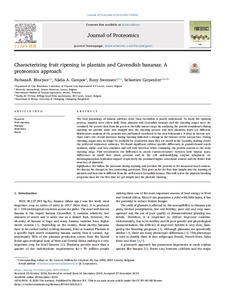| dc.contributor.author | Bhuiyan, F. |
| dc.contributor.author | Campos, N.A. |
| dc.contributor.author | Swennen, R. |
| dc.contributor.author | Carpentier, S. |
| dc.date.accessioned | 2020-03-04T09:03:20Z |
| dc.date.available | 2020-03-04T09:03:20Z |
| dc.date.issued | 2020 |
| dc.identifier.citation | Bhuiyan, F., Campos, N.A., Swennen, R. & Carpentier, S. (2020). Characterizing fruit ripening in plantain and Cavendish bananas: a proteomics approach. Journal of Proteomics, 214, 1-11. |
| dc.identifier.issn | 1874-3919 |
| dc.identifier.uri | https://hdl.handle.net/20.500.12478/6808 |
| dc.description.abstract | The fruit physiology of banana cultivars other than Cavendish is poorly understood. To study the ripening process, samples were taken daily from plantain and Cavendish bananas and the ripening stages were determined. We present data from the green to the fully mature stage. By analyzing the protein abundances during ripening we provide some new insights into the ripening process and how plantains fruits are different. Multivariate analysis of the proteins was performed correlated to the starch dynamics. A drop in sucrose synthase and a rise of acid invertase during ripening indicated a change in the balance of the sucrose fate. During ripening, sugars may no longer be available for respiration since they are stored in the vacuoles, making citrate the preferred respiratory substrate. We found significant cultivar specific differences in granule-bound starch synthase, alpha- and beta amylases and cell wall invertase when comparing the protein content at the same ripening stage. This corroborates the difference in starch content/structure between both banana types. Differences in small heat shock proteins and in the cell wall-modifying enzyme xyloglucan endotransglucosylase/hydrolase support respectively the presumed higher carotenoid content and the firmer fruit structure of plantains.
Significance
We follow the proteome during ripening and correlate the proteins to the measured starch content. We discuss the changes in two contrasting genotypes. This gives us for the first time insight into the ripening of plantain and how this is different from the well-known Cavendish banana. This will revive the plantain breeding programs since for the first time we get insight into the plantain ripening. |
| dc.description.sponsorship | United States Agency for International Development |
| dc.format.extent | 1-11 |
| dc.language.iso | en |
| dc.subject | Fruits |
| dc.subject | Ripening |
| dc.subject | Ripening Stage |
| dc.subject | Plantains |
| dc.subject | Starch |
| dc.subject | Proteins |
| dc.subject | Bananas |
| dc.title | Characterizing fruit ripening in plantain and Cavendish bananas: a proteomics approach |
| dc.type | Journal Article |
| cg.contributor.crp | Roots, Tubers and Bananas |
| cg.contributor.affiliation | Katholieke Universiteit, Leuven |
| cg.contributor.affiliation | Bioversity International |
| cg.contributor.affiliation | International Institute of Tropical Agriculture |
| cg.contributor.affiliation | University of Chittagong |
| cg.coverage.region | Europe |
| cg.coverage.country | Belgium |
| cg.coverage.hub | Eastern Africa Hub |
| cg.creator.identifier | Rony Swennen: 0000-0002-5258-9043 |
| cg.researchtheme | Biotech and Plant Breeding |
| cg.identifier.bibtexciteid | BHUIYAN:2020 |
| cg.isijournal | ISI Journal |
| cg.authorship.types | CGIAR and developing country institute |
| cg.iitasubject | Agronomy |
| cg.iitasubject | Banana |
| cg.iitasubject | Plant Breeding |
| cg.iitasubject | Plant Production |
| cg.iitasubject | Plantain |
| cg.journal | Journal of Proteomics |
| cg.notes | Open Access Article; Published online: 28 Dec 2019 |
| cg.accessibilitystatus | Open Access |
| cg.reviewstatus | Peer Review |
| cg.usagerightslicense | Creative Commons Attribution 4.0 (CC BY 0.0) |
| cg.targetaudience | Scientists |
| cg.identifier.doi | https://dx.doi.org/10.1016/j.jprot.2019.103632 |

